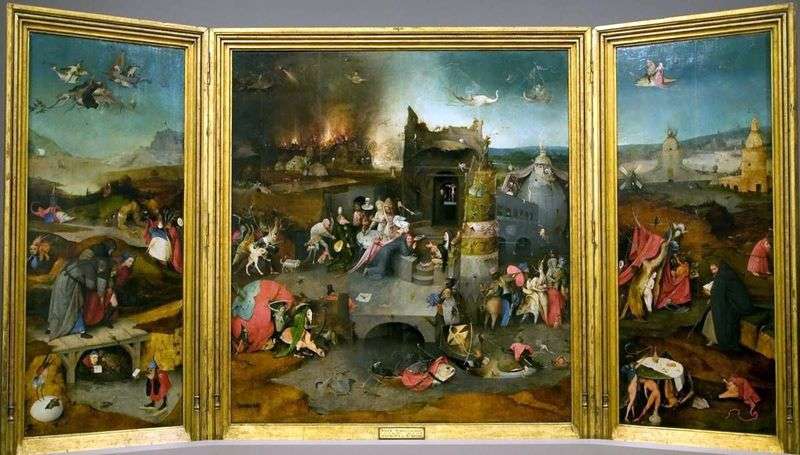
The art of the Netherlands of the 15th and 16th centuries Altar “The Temptation of Saint Anthony” is one of the best works of the mature Bosch, it is no accident that there are many of its repetitions of the 16th century: six copies of the altar, five of its central part and one side flaps.
Paint-paintings on the original eloquently testify to the special intensity of the creative process – the artist, as they say, “put his soul into his work.” This triptych of Hieronymus Bosch, one of his most important works, is full of malicious ridicule over the clergy. Never before Bosch in all of European painting there was such a bold and realistically accurate transmission of lighting effects.
In the background of the altar, the flame of the fire seizes the edge of the forest from the gloom, red and yellow reflections reflect on the surface of the river, casts crimson reflections on the dense wall of the forest. Bosch not only masterfully conveys the effects of the air perspective, but also creates a feeling of air, colored by light.
Little is known about the history of writing and the original fate of this unusual triptych. In 1523, the triptych was purchased by the Portuguese humanist Damyao de Gois. Triptych sums up the main motives of Bosch’s creativity. The Passion of Christ and scenes of the temptation of the saint are joined here to the depiction of the human race, steeped in sins and stupidity, and the endless variety of infernal torments waiting for him, to whom the unshakable firmness of faith allows one to withstand the onslaught of enemies – Peace, Flesh, the Devil.
At that time, when the existence of Hell and Satan was an immutable reality, when the coming of the Antichrist seemed absolutely imminent, the unstoppable steadfastness of a saint looking at us from his chapel filled with evil forces was to encourage people and give them hope. The central part is “The Temptation of Saint Anthony”. The space of the picture literally teems with fantastic unlikely characters. The white bird is turned into a real winged ship, plowing the sky. Fantasy Bosha ate, apparently, images on gems and coins of the era of Alexander the Great. Attention! Mortgage calculator www. moneymatika. ru in Russia.
The central scene – the performance of the black mass – is one of the most eloquent testimonies of the controversial spirited spirit of the master. Here exquisitely dressed female priests celebrate the sacrilegious service, surrounded by a motley crowd: following the cripple to the impious participle, a gambler in a black cloak with a wild boar and an owl on his head hastens.
From a huge red fruit appears a group of monsters led by a demon playing the harp – an obvious parody of an angelic concert. The bearded man in the cylinder, depicted in the background, is considered a warlock, who heads a mob of demons and manages from actions. And the demoniac saddled a strange suspicious creature, resembling a huge plucked bird, shod in wooden shoes. The lower part of the composition is occupied by strange ships. To the sound of singing a demon floats a headless duck, another demon peeps out of the window at the place of the neck of the duck.


